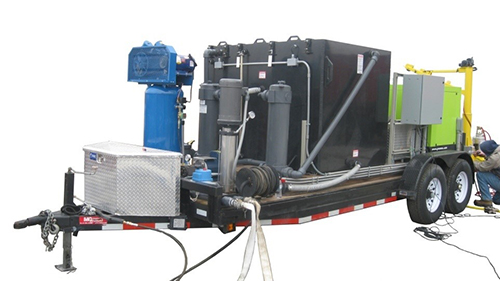DOTWASH Tackles Invasive Species Catching a Ride on Construction Vehicles
Tiny plants can cause big problems. Invasive species and noxious weeds can destroy entire ecosystems, stemming from something as seemingly innocuous as a seed latching to the bottom of a dump truck that then travels across varied ecological biosystems, wreaking havoc.
Non-native invasive plants are spreading at an alarming rate—4,600 acres per day—on federal lands in the western United States, according to the Bureau of Land Management. These plants can destroy wildlife habitats, threaten endangered species and native plants, increase soil erosion and groundwater loss, and block recreational opportunities.
Sheilah Kennedy, former coordinator of Okanogan County Noxious Weed Control in Washington and founder of S-K Environmental, has made it her mission to find a preventive solution to the noxious weed problem.
“Our goal was to provide something that was effective and efficient in eliminating invasive species on construction projects,” said Kennedy. “State Departments of Transportation are our main audience. The more we can put into prevention of invasive species—as opposed to long-term integration programs once the species is established—the better off all parties will be.”
SBIR Funds User-Friendly System for Invasive Species Prevention
The U.S. DOT Small Business Innovation Research (SBIR) program is a highly competitive, awards-based program that encourages domestic small businesses to conduct high-priority research within U.S. DOT.
Through SBIR and with funding from the Federal Highway Administration, S-K Environmental developed a novel solution called the DOTWASH Portable Rinse-off & Reclaim System to address the invasive species issue.

The DOTWASH system cleans seeds and plant particles from trucks and construction equipment, and curtails the spread of invasive species. (S-K Environmental photo)
Before a construction vehicle leaves a worksite, the operator drives the equipment onto the DOTWASH reclaim mat, where seeds and debris collect. The vehicle’s weight activates a powerful pressure wash.
During a final rinse cycle, an electrostatic nozzle sprays herbicide on the equipment surface. As the electrically charged fluid moves upward, it attracts the herbicide to the equipment. The herbicide system kills all seeds, including any that may remain on a truck’s undercarriage, and is successful at least 97 percent of the time.
Everything that falls onto the reclaim mat is processed through a collection tank, where spores and seeds are filtered and sent to a holding tank. The filtered water can then be used again on another vehicle. No run-off, debris, or contaminants are left onsite.
To maximize the impact of the system and minimize inconvenience, it is designed to be used year-round. DOTWASH has another benefit in the winter: the tank can be filled with a neutralizing solution to prevent equipment corrosion from de-icing materials.
Education at the Forefront
Kennedy’s greatest challenge wasn’t in creating the technology: It’s in education. Whenever Kennedy travels to promote the product, she teaches people about how and why invasive species are a threat.
“Education is the biggest thing,” said Kennedy. “You have to let people know that yes, they can be pretty flowers, but they have a severe impact on the environment.”
S-K Environmental’s goal is to commercialize DOTWASH and see commercial applications successfully launched in every state.

